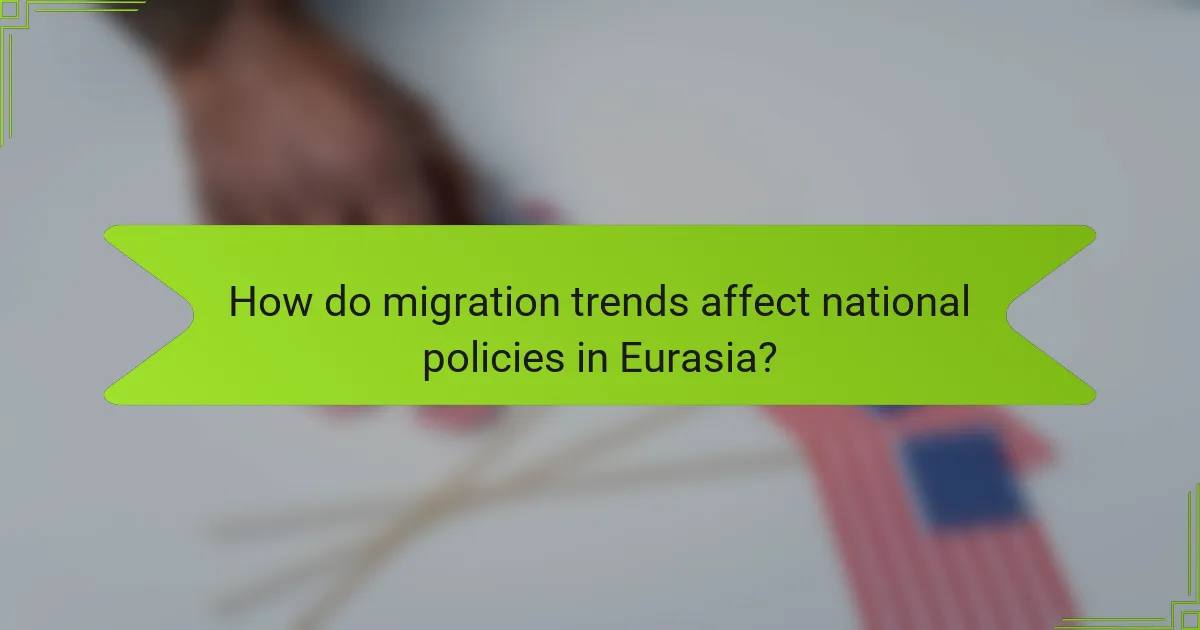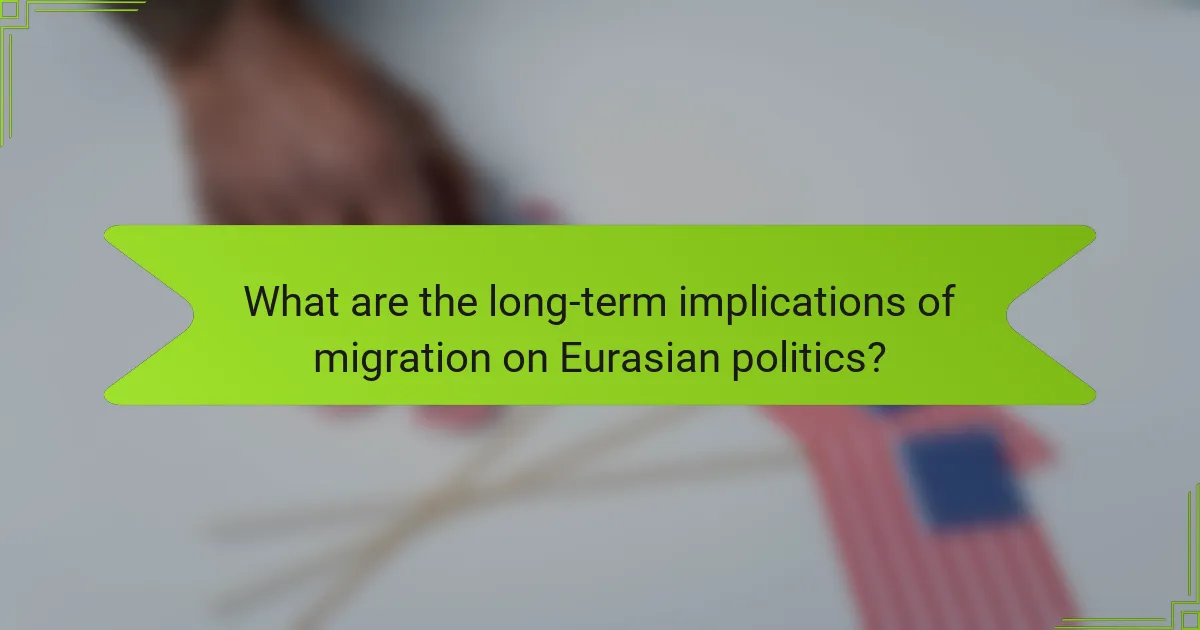Migration trends in Eurasia highlight significant movements from Central Asian countries to Russia, driven primarily by economic opportunities and influenced by geopolitical tensions, such as conflicts in Ukraine and Belarus. The COVID-19 pandemic has further altered these flows, leading to increased internal displacement and returns to home countries. These trends necessitate changes in national immigration policies, as countries adapt to labor demands and social integration challenges. Additionally, migration impacts the political landscape, reshaping demographic compositions and altering power dynamics within nations. Overall, the interplay of economic, political, and social factors underscores the complexity of migration’s effects on Eurasian politics.

What are the current migration trends in Eurasia?
Current migration trends in Eurasia show significant movement from Central Asian countries to Russia. Economic opportunities drive many migrants to seek work in Russian cities. Additionally, geopolitical tensions influence migration patterns. For instance, conflicts in Ukraine and Belarus have led to increased migration towards Western Europe. Moreover, the COVID-19 pandemic has altered migration flows, with many returning to their home countries. Data from the International Organization for Migration indicates a rise in internal displacement within countries like Ukraine. Overall, these trends reflect a complex interplay of economic, political, and social factors affecting migration in the region.
How do these migration trends impact political landscapes?
Migration trends significantly impact political landscapes by altering demographic compositions and influencing policy decisions. Increased migration can lead to changes in voter demographics, often shifting political power towards more diverse groups. For example, in countries like Germany, the influx of migrants has prompted political parties to adapt their platforms to address the needs and concerns of these populations.
Additionally, migration can strain public resources and services, leading to political tensions and debates over immigration policies. In some cases, it has fueled the rise of nationalist movements that oppose immigration, as seen in various Eastern European countries.
Moreover, migration trends can affect international relations, as governments negotiate treaties and agreements to manage migrant flows. The European Union has implemented policies aimed at managing migration and ensuring member states cooperate on these issues.
Overall, the effects of migration trends on political landscapes are profound, influencing elections, party dynamics, and policy frameworks across nations.
What specific political changes have been observed due to migration?
Migration has led to significant political changes, including shifts in policy and governance. One notable change is the increase in multicultural policies in host countries. Countries like Germany have implemented integration programs to accommodate migrants. Additionally, migration has influenced electoral outcomes in various nations. In the United States, demographic shifts due to migration have altered voting patterns.
Moreover, migration has prompted changes in immigration laws and border security measures. For example, the European Union has tightened border controls in response to increased migration flows. Social tensions have also risen in some regions, leading to the rise of nationalist political movements. These movements often advocate for stricter immigration policies.
Overall, migration has reshaped political landscapes by affecting policy, governance, and societal dynamics across Eurasia.
How do migration trends influence political alliances in Eurasia?
Migration trends significantly influence political alliances in Eurasia by reshaping demographic landscapes and economic dependencies. Increased migration often leads to shifts in population dynamics, which can alter political power balances. For instance, countries experiencing high levels of immigration may seek alliances with nations that share similar demographic challenges or economic needs.
Moreover, migration can foster cultural exchanges that enhance diplomatic relations. Countries that host large migrant populations may prioritize partnerships with the migrants’ countries of origin. This is evident in Central Asia, where labor migration affects bilateral ties between sending and receiving nations.
Economic factors also play a crucial role. Nations that rely on migrant labor for economic stability may align politically with countries that facilitate migration flows. For example, Russia’s alliances with Central Asian states are partly driven by its dependence on migrant workers for various sectors.
Additionally, migration can lead to security concerns, prompting countries to form alliances for border control and mutual defense. Countries facing similar migration pressures may collaborate on policies to manage these challenges effectively.
In summary, migration trends in Eurasia shape political alliances through demographic changes, economic dependencies, cultural ties, and security considerations.
What factors drive migration in the Eurasian region?
Economic opportunities drive migration in the Eurasian region. Many individuals seek better job prospects in urban areas. Political instability in certain countries also prompts migration. Conflict and violence force people to flee their homes. Additionally, environmental factors like climate change impact migration patterns. Social networks often facilitate movement, as migrants connect with family and friends abroad. Historical ties between nations influence migration trends as well. These factors collectively shape the demographic landscape of Eurasia.
How do economic conditions affect migration patterns?
Economic conditions significantly influence migration patterns. Individuals often migrate from regions with poor economic prospects to areas offering better job opportunities. For instance, during economic downturns, countries may experience increased emigration as people seek stability elsewhere. Conversely, economic growth in a region can attract migrants looking for employment and improved living standards.
Data from the International Organization for Migration shows that economic factors are among the top reasons for migration globally. In 2020, 72% of surveyed migrants cited job prospects as a primary motivation for relocating. Economic conditions also shape government policies on immigration, affecting how welcoming a country is to newcomers.
Overall, the relationship between economic conditions and migration is complex and dynamic, impacting both the origin and destination countries.
What role does conflict play in shaping migration trends?
Conflict significantly influences migration trends by displacing populations and creating refugees. Armed conflicts often lead to instability and insecurity in affected regions. This instability forces individuals and families to flee their homes in search of safety. According to the United Nations High Commissioner for Refugees (UNHCR), there were over 26 million refugees worldwide in 2021, many due to conflict. Additionally, conflicts can alter demographic patterns, as people migrate to neighboring countries or regions. For example, the Syrian civil war resulted in millions of Syrians migrating to Europe and neighboring countries. This migration can reshape political landscapes, as host countries must respond to the influx of migrants. In summary, conflict acts as a catalyst for migration, significantly impacting both the origin and destination countries.

How do migration trends affect national policies in Eurasia?
Migration trends significantly influence national policies in Eurasia. Countries in this region adapt their immigration laws in response to changing migration patterns. For instance, increased labor migration from Central Asia has led Russia to implement policies that facilitate work permits. These policies aim to address labor shortages in specific sectors. Additionally, countries like Kazakhstan have adjusted their citizenship laws to attract skilled migrants.
Eurasian nations also adjust their social policies to integrate migrants effectively. This includes providing access to education and healthcare services. The rising number of refugees from conflict zones further prompts nations to revise their asylum policies. Countries like Turkey have adopted more open refugee policies in response to the Syrian crisis.
Overall, migration trends compel Eurasian governments to balance economic needs with social cohesion. This dynamic shapes national policies across the region.
What policies have been implemented in response to migration?
Countries have implemented various policies in response to migration. These policies include stricter border controls to manage the flow of migrants. Many nations have established refugee resettlement programs to assist those fleeing conflict. Additionally, some governments have introduced work permits to regulate labor migration. Economic integration initiatives aim to support migrants in contributing to local economies. Enforcement of immigration laws has increased to deter illegal crossings. Bilateral agreements between countries facilitate managed migration pathways. Public awareness campaigns address the benefits and challenges of migration. These policies reflect the complex dynamics of migration within Eurasian politics.
How do countries adapt their immigration laws based on migration trends?
Countries adapt their immigration laws based on migration trends by analyzing demographic changes and labor market needs. They assess patterns of incoming migrants, such as skills, nationalities, and reasons for migration. For instance, if a country experiences an influx of skilled workers, it may streamline visa processes for professionals. Conversely, an increase in asylum seekers may lead to more stringent border controls.
Countries also monitor economic indicators to align immigration policies with labor shortages. For example, during economic growth, nations may expand work permit programs to attract foreign labor. Historical events, like conflicts or natural disasters, can prompt rapid legal adjustments to accommodate displaced populations.
Data from organizations like the International Organization for Migration supports these trends. Reports show that countries regularly revise policies to respond to shifting migration flows. Such adaptations ensure that immigration laws reflect current social and economic realities.
What are the social policies related to integration of migrants?
Social policies related to the integration of migrants focus on facilitating their inclusion into society. These policies typically include access to education, healthcare, and employment opportunities. They aim to promote social cohesion and prevent discrimination. Language training programs are often implemented to enhance communication skills. Legal frameworks may be established to protect migrants’ rights. Community engagement initiatives encourage interaction between migrants and local residents. Financial support programs can assist with settlement costs. Evidence shows that effective integration policies lead to better economic outcomes for both migrants and host countries.
How do public perceptions of migration influence political decisions?
Public perceptions of migration significantly influence political decisions. Politicians often align their policies with the views of their constituents. Negative perceptions can lead to stricter immigration laws. For example, in many European countries, rising anti-immigrant sentiment has resulted in more stringent border controls. Surveys indicate that public concerns about job competition and cultural integration shape political discourse. In response, parties may adopt populist rhetoric to gain voter support. This trend has been observed in elections across Eurasia. Political leaders frequently use migration as a campaign issue to mobilize voter bases.
What role does media play in shaping public opinion on migration?
Media significantly influences public opinion on migration. It shapes narratives through coverage and framing of migrant stories. For example, positive portrayals can foster empathy, while negative representations may incite fear. Research shows that extensive media coverage correlates with heightened public awareness and concern regarding migration issues. A study by the Pew Research Center found that 62% of adults believe news media influences their views on immigration. Additionally, social media platforms amplify these narratives, reaching broader audiences rapidly. This dynamic can mobilize public sentiment, affecting policy discussions and political agendas related to migration.
How do political parties leverage migration issues for electoral gain?
Political parties leverage migration issues for electoral gain by framing immigration as a key concern for voters. They often highlight the economic impact of migration, emphasizing job competition and strain on public services. This strategy aims to evoke fear and concern among constituents. Political parties may also use migration narratives to rally support for stricter immigration policies. For example, during elections, parties may present themselves as protectors of national identity and security. Research shows that parties focusing on anti-immigration rhetoric can increase voter turnout among certain demographics. In various Eurasian countries, migration issues have been pivotal in shaping political platforms and electoral outcomes.

What are the long-term implications of migration on Eurasian politics?
Migration significantly influences Eurasian politics over the long term. It reshapes demographic compositions within countries. This change can lead to altered political power dynamics. For instance, increased migration may empower minority groups. Such shifts can result in enhanced representation in political institutions. Migration also affects economic policies as governments respond to labor market changes. The integration of migrants can lead to social tensions or cohesion, impacting political stability. Historical examples, like the migration patterns following the Soviet Union’s collapse, illustrate these dynamics. Overall, migration will continue to play a crucial role in shaping the political landscape of Eurasia.
How might future migration trends reshape political dynamics?
Future migration trends are likely to significantly reshape political dynamics by altering demographic compositions. Increased migration can lead to shifts in voting patterns as new populations bring different political preferences. For instance, studies show that urban areas with high immigration rates often lean more liberal. This can result in changes to local policies and governance styles. Additionally, migration may intensify debates around national identity and cultural integration. Countries experiencing substantial influxes may face pressure to adapt their immigration policies. Historical patterns indicate that migration can also provoke nationalist movements, as seen in various European nations. Overall, the political landscape could become more polarized as diverse groups vie for representation and influence.
What potential conflicts could arise from changing migration patterns?
Changing migration patterns can lead to several potential conflicts. These conflicts often arise from competition for resources. Increased migration can strain housing, healthcare, and education systems in host countries. This strain can lead to social tensions and xenophobia among local populations.
Economic disparities between migrants and locals may fuel resentment. Job competition can lead to wage suppression for native workers. Cultural differences might also create friction in communities. Historical grievances can resurface, exacerbating divisions.
For instance, the Syrian refugee crisis has shown how sudden influxes can destabilize neighboring countries. Countries like Turkey and Lebanon have faced significant challenges due to large numbers of migrants. This situation illustrates how migration can impact regional stability and relations.
How could migration influence regional stability in Eurasia?
Migration can significantly influence regional stability in Eurasia. It can lead to demographic shifts, altering the cultural and social fabric of communities. Increased migration often results in competition for resources, which may heighten tensions among local populations. For example, the influx of migrants can strain public services and infrastructure, leading to social unrest.
Moreover, migration can affect political dynamics. Migrant populations may push for political representation and rights, challenging existing power structures. This can create friction between different ethnic or national groups. In some cases, governments may exploit migration issues to consolidate power or divert attention from internal problems.
Historical data shows that regions with high migration rates often experience both economic growth and social challenges. The 2015 migrant crisis in Europe serves as a case study, demonstrating how sudden population shifts can lead to political polarization. Thus, migration is a double-edged sword, with the potential to both enrich and destabilize regions in Eurasia.
What strategies can policymakers adopt to address migration challenges?
Policymakers can adopt several strategies to address migration challenges effectively. First, they can implement comprehensive immigration reform. This reform should streamline processes for legal migration while ensuring border security. Second, they can enhance international cooperation with origin and transit countries. Collaborative agreements can address root causes of migration, such as conflict and poverty. Third, policymakers can invest in integration programs for migrants. These programs should focus on language acquisition and job training to facilitate social cohesion.
Additionally, they can develop data-driven policies that monitor migration trends. Accurate data can inform better decision-making and resource allocation. Moreover, policymakers should engage with local communities to address concerns and promote understanding. Finally, they can establish legal pathways for migration to reduce irregular flows. These strategies can create a more balanced approach to migration challenges in Eurasia.
How can countries collaborate to manage migration effectively?
Countries can collaborate to manage migration effectively through coordinated policies and information sharing. Joint efforts can include establishing common legal frameworks for migration. International agreements can facilitate the safe movement of people. Countries can share data on migration trends and patterns to enhance understanding. Collaborative border management can improve security and streamline processes. Regional organizations can foster dialogue and cooperation among member states. Capacity building initiatives can support countries facing high migration pressures. Lastly, addressing root causes of migration through development aid can reduce the need for people to migrate.
What best practices exist for integrating migrants into society?
Best practices for integrating migrants into society include language acquisition programs, access to education, and employment opportunities. Language programs help migrants communicate effectively in their new environment. Access to education allows migrants to gain necessary skills and knowledge. Employment opportunities provide financial independence and promote social inclusion. Community engagement initiatives foster relationships between migrants and local residents. Cultural exchange programs enhance mutual understanding and respect. Legal support services assist migrants in navigating immigration processes. Research shows that countries with comprehensive integration policies experience more successful outcomes for migrants. For instance, a study by the Migration Policy Institute highlights the importance of targeted integration strategies in improving social cohesion.
The main entity of this article is migration trends in Eurasia and their impact on politics. The article examines the significant movement of people from Central Asia to Russia driven by economic opportunities, as well as the influence of geopolitical tensions and conflicts in shaping migration patterns. It discusses how these trends affect political landscapes, including changes in voter demographics, policy adaptations, and the rise of nationalist movements. Additionally, the article highlights the role of economic conditions, conflict, and public perceptions in shaping migration-related policies and societal dynamics across the region.